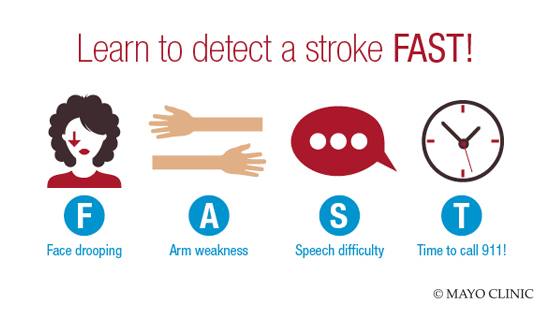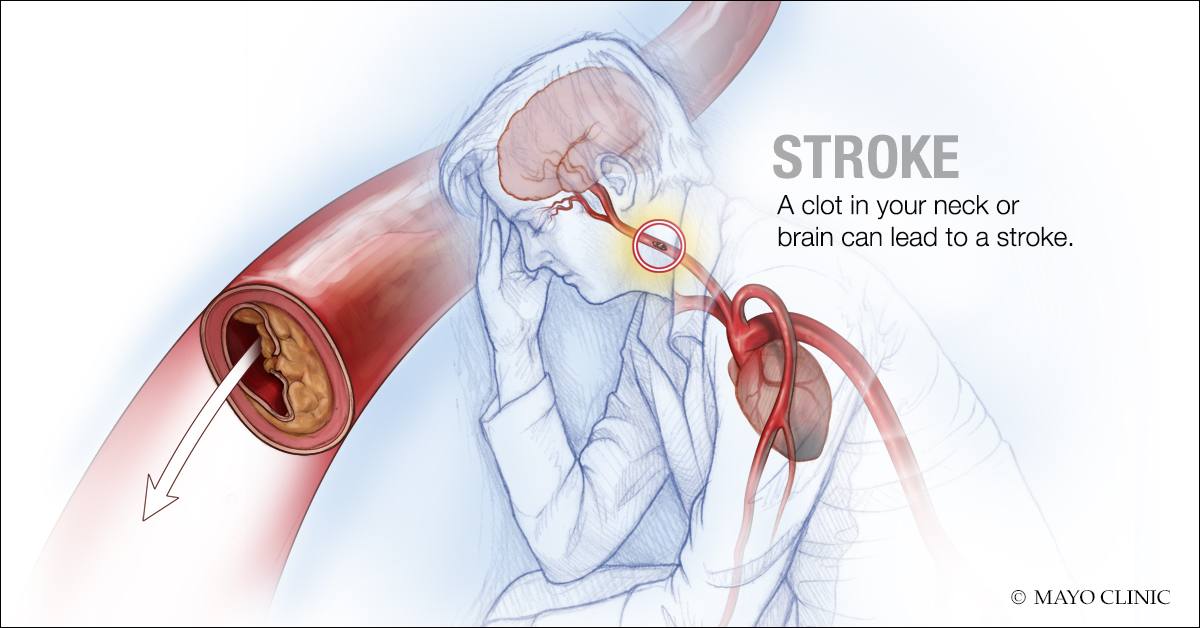
ROCHESTER, Minn. — "Time is brain."
That's the mantra for responding to stroke, a medical emergency that occurs when the blood supply to part of the brain is interrupted or reduced, depriving tissue of oxygen and nutrients. Within minutes, brain cells begin to die.
Every second counts, and the faster a patient gets treatment, the better the odds for a positive outcome.
That message hasn't changed through all the advances in research and treatment over the past several years. And Mayo Clinic experts are reinforcing the message that a FAST response is crucial, in recognition of National Stroke Awareness Month in May.
"FAST" is the acronym for keywords identifying signs and symptoms of stroke, with "Time" being the final and most important factor:
- Face: Is the person's face drooping on one side?
- Arms: Can the person raise both arms without one or both falling?
- Speech: Slurring or difficulties in speaking are a sign of trouble.
- Time: Every second counts. With one or more of these symptoms, call 911 or your emergency phone line immediately.
Latest in diagnosis, treatment
Stroke is the No. 5 cause of death and the leading cause of disability in the U.S., according to the American Stroke Association. But with the latest treatment options and telemedicine capabilities at some hospitals, many patients are having positive outcomes that would have been unlikely not long ago.
"For so many years, stroke wasn't as treatable as we wish it could have been," says Robert D. Brown Jr., M.D., a Mayo Clinic neurologist. "When I was back in my training in the late 1980s, we didn't have good options in the early hours following stroke onset."

That changed dramatically in the 1990s with the advent of clot-busting drugs, which changed the mindset regarding the importance of urgent treatment for ischemic strokes, the most common type of strokes, Dr. Brown says. Ischemic strokes occur when blood vessels to the brain are narrowed or blocked. More recently, the use of mechanical thrombectomy to remove clots from blood vessels in certain cases has been another breakthrough.
There also have been advances in treating hemorrhagic strokes, which are caused by the rupture of weakened blood vessels. Newer surgical treatments, including infusing clot-dissolving drugs into an area of the brain where bleeding has occurred, are being assessed to improve outcomes, says Dr. Brown, the John T. and Lillian Mathews Professor of Neuroscience.
Some advanced techniques and imaging tools are available only at major medical centers. In other communities, "telestroke" programs are making a difference in stroke outcomes. Stroke experts use video cameras and other technology to evaluate patients remotely, diagnose stroke types and recommend treatments.
At Mayo Clinic's Florida campus, portable telestroke equipment recently was deployed in ambulances. This equipment enabled physicians to begin their assessments prior to the patient's arrival at the hospital. "This program has effectively reduced the time between stroke onset and emergency stroke treatment," says Bart Demaerschalk, M.D., a Mayo Clinic neurologist. The program also is being developed at other Mayo campuses.
Mayo Clinic researchers also are leading an international clinical study, called the Carotid Revascularization and Medical Management for Asymptomatic Carotid Stenosis Study (CREST-2), which aims to determine the optimal treatment for stroke prevention in patients who have been diagnosed with carotid artery disease. This disease occurs when fatty deposits, or plaques, clog the blood vessels that deliver blood to the brain and head. Kevin Barrett, M.D., a Mayo Clinic neurologist, says it's the largest stroke prevention study underway, with over 1,300 patients enrolled at 128 centers to date.
"Historically, surgical treatments such as carotid endarterectomy or carotid artery stenting have been used to more or less clear out the plaque that's associated with narrowing in the carotid artery," Dr. Barrett says. But intensive medical management approaches have emerged as an alternative way to prevent strokes, including lifestyle changes and the use of drug therapies.
Prevention is key
Though much has changed over the years in how health care providers respond to stroke, preventive measures for reducing its risk remain as constant and important as ever:
"High blood pressure, or hypertension, is a very strong risk factor for stroke," Dr. Brown says.
"Smoking markedly increases the risk for stroke," not to mention other negative health impacts, he says.
Lower your low-density lipoprotein, or LDL or "bad," cholesterol, eat a healthy diet and maintain an appropriate weight.
"It doesn't have to be an extravagant amount of exercise. Even a small amount on an ongoing basis is a stroke preventive and will benefit your heart as well," Dr. Brown says.
To schedule an interview with a stroke expert, contact Mayo Clinic Public Affairs, newsbureau@mayo.edu.
###
About Mayo Clinic
Mayo Clinic is a nonprofit organization committed to clinical practice, education and research, providing expert, comprehensive care to everyone who needs healing. Learn more about Mayo Clinic. Visit the Mayo Clinic News Network.
Media contacts:
- Susan Barber Lindquist, Mayo Clinic Public Affairs, 507-284-5005,
newsbureau@mayo.edu - Jim McVeigh, Mayo Clinic Public Affairs, 480-301-4222, mcveigh.jim@mayo.edu
- Kevin Punsky, Mayo Clinic Public Affairs, 904-953-0746, punsky.kevin@mayo.edu







